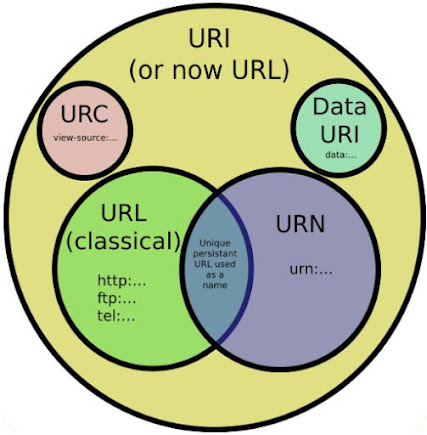Internationalized Resource Identifier (IRI)
An Internationalized Resource Identifier (IRI) is a standard proposed by the IETF (RFC 3987). An IRI is a unique sequence of characters that identifies a resource.
IRIs are a generalization of URIs (RFC3986) that permits a wider range of Unicode characters.
A Uniform Resource Identifier (URI) is a unique sequence of characters that identifies an abstract or physical resource. The difference between an IRI and a URI is that IRIs use the more modern Universal Character Set (a.k.a. UNICODE) and URIs use the older ASCII character set. The newer IRI format is compatible with the older URI format. The most current version of RDF uses IRIs to identify resources.
Don't confuse IRIs with URLs and URNs. A URL is a web address. A URN is a Uniform Resource Name. This Venn diagram shows the relationship between these different tools:
Why are IRIs and URIs important? If you are thinking in terms of a single database, a silo of data, then IRIs and URIs might not make much sense. But, if you are a systems thinker then why you need IRIs/URIs becomes very clear.- Standards-based approach to identifying resources: Lots of different vendors coming up with lots of different approaches to uniquely identify a resource then requires middleware to reconcile the different approaches.
- Globally unique: IRIs are globally unique. Database resource identifiers are local only. Database identifiers only mean what you think they mean in the context of a specific database. Outside that database the identifiers are meaningless and can conflict with some other identifier. GUIDs (Guaranteed Unique Identifiers, like this 748afe65-97a9-46ac-b218-d8fe0be2b2be) can work, but uniqueness is not really guaranteed and they can be opaque and it can be harder to figure out what the GUID actually means.
- Resolvable: Because IRIs are based on domain names which are unique and registered with a DNS (Domain Name Server), you can know where to go to resolve them (find out what they mean). It is up to the creator of the IRI to use best practices when they publish information; but if they do users of the information can understand what the information means. For example, here is the IRI from DBpedia for Microsoft, Google, Apple (the fruit), SalesForce, Amazon (what do you mean?), and Cadbury.
Additional Information:




Comments
Post a Comment